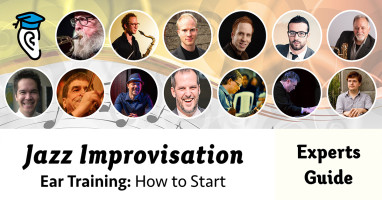Jazz improvisation is notoriously complicated – but it doesn’t need to be. Developing a jazz ear requires a range of techniques and practices, so when we recently compiled our Jazz Ear Training Experts Guide the experts offered a variety of advice. To help you get started easily we’ve boiled it down to the core advice in five areas which you can think of as the “master tools” used by the experts in jazz improvisation.
We invited thirteen of the leading jazz improvisation educators to contribute to the Experts Guide, and in this post we’ve tried to summarise and combine the top tips they each gave:
- Martan Mann (JazzSkills for Piano)
- Matt Warnock (Matt Warnock Guitar)
- Denis DiBlasio (The Maynard Ferguson Institute of Jazz)
- William Flynn (Wichita State University)
- Mike Lebrun (The Woodshed)
- Chris Cooke (LearnJazzFaster.com)
- Dr. Ed Byrne (Byrne Jazz)
- Mark Meronek (Pianobreaks.com)
- Julian Bradley (Jazz Tutorial)
- Willie Thomas (JazzEveryone.com)
- Marc-Andrew Seguin (JazzGuitarLessons.net)
- Steve Nixon (FreeJazzLessons.com)
- Camden Hughes (Learn Jazz Standards)
The five master tools which emerged were: Your Ears, Voice, Hands, Brain and Heart. For each one there are exercises and skills you can hone to improve your jazz ear and improvisational chops. Read on to find out how!
1. Ears
“Listen to all the jazz you can.”
– Camden Hughes, LearnJazzStandards.com
Jazz is a language. The first step to learning any language is to listen. As Mike Lebrun put it: “As an improviser, your ear is your most important tool. If you can hear it, and I mean really hear it, chances are you are going to be able to play it.”
→ Learn more about active listening
Intervals are the building blocks of all melody and harmony. Martan Mann, Denis DiBlasio, Dr. Ed Byrne, Steven Nixon and Camden Hughes all recommended learning intervals for jazz improvisation. Learn to hear them and play them and you will have greater freedom in finding the next note as you improvise.
“Play a simple melody slowly… starting on different notes. This helps the inner ear learn to “take aim” at the next note.”
– Denis DiBlasio
Transcribe what you hear: master jazz solos or anything from TV commercials to “the cricket symphony in your backyard.” (Dr. Ed Byrne) More than half the experts recommended transcription as part of learning to improvise jazz. But remember that this writing down part comes last in a sequence of more important steps, including singing solos and solfeggio, explained further below.
→ Learn more about transcription
Learn the accent. Listen for and mimic articulations, contour, and swing.
“Much of the magic in a great jazz solo comes not from the notes themselves, but from the ways in which the notes are played.”
– William Flynn
2. Voice
Sing famous jazz solos. An instrument can be played mechanically, but singing internalizes the language of jazz improvisation more directly than playing your instrument. Singing is the first step to transcription.
→ Learn more about singing ear training
Solfeggio takes singing what you hear (in your environment or in your head) a step further:
“The beauty of solfeggio is in its naming of the relationship of each and every note within the key—in a single syllable.”
– Dr. Ed Byrne, Byrne Jazz
3. Hands
Play it! Once you can hear and sing a jazz solo, whether it is your own or someone else’s, play and practice it on your instrument transposed to all keys.
“I have discovered that you can listen to jazz all day long and not get a lot better…”
– Willie Thomas, JazzEveryone.com
→ Learn more about instrumental ear training
Follow your ear on your instrument. As Julian Bradley of Jazz Tutorial explains, “The goal with improv is to transcribe the melody that is already playing in your imagination – and then to play it in real time through your instrument.”
Chris Cooke offers this advice: “Practice letting your ear guide your playing while improvising. This means you’ll have to keep it simple.”
→ Learn more about audiation (hearing music in your head)
Slow down! Learn to walk before trying to run. Julian Bradley shared “It took me years to realize this. I used to practice improvising at full tempo, and I’d get nowhere. You have to slow down the piece while you practice, and gradually speed up when ready.”
4. Brain
Learn your theory: scales, chords, and solfeggio. Apply the same listening, singing, and practicing techniques to your scales, chords, and chord progressions as you did with jazz solos.
“Improvisation is 50% theory and 50% your ear.”
– Julian Bradley, Jazz Tutorial
Learn your chord progressions. Start with the V-I progression, and then move on to the 12-bar blues.
→ Learn more about the 12-bar blues and chord progressions
5. Heart
Learning with ears, voice, and hands helps us to internalize everything.
Play it by heart: memorize solos and chord progressions.
“When people make mistakes and they’re reading, they look “outside” themselves for the answer, on the page. But if they’re playing from memory they look to their ears, “inside” themselves for the answer.”
– Mark Meronek, Pianobreaks.com
“Learn the music you love.”
– Chris Cooke, LearnJazzFaster.com
Becoming an expert in jazz improvisation is a journey which will take years, but if you work on each of these five master tools in the ways explained above you will be able to improve your jazz ear quickly and steadily and enjoy the benefits in more creative, fluid and confident jazz improvisation.
Thanks again to our thirteen experts who contributed to the full guide. To learn more about them and the jazz improv advice they gave, see the full Experts Guide: “How to Start Jazz Improvisation Ear Training”:








